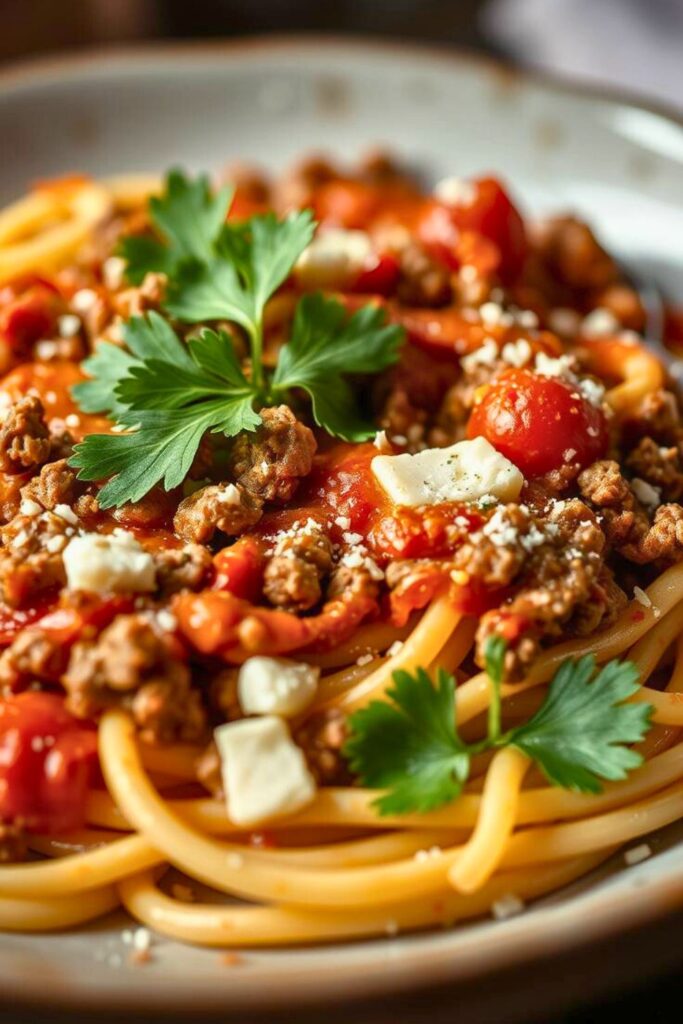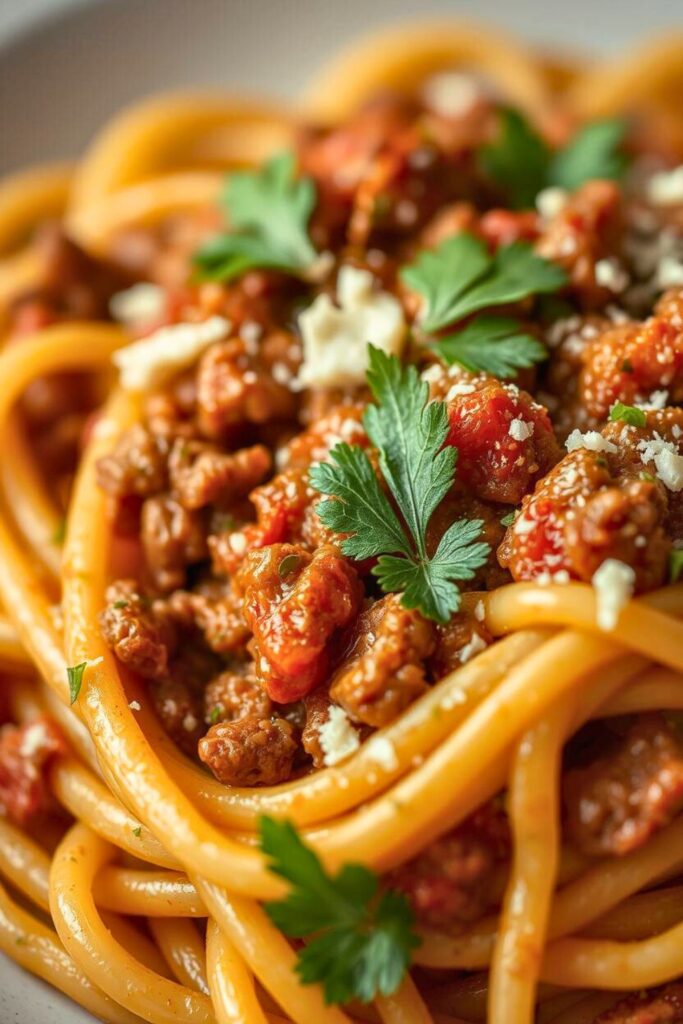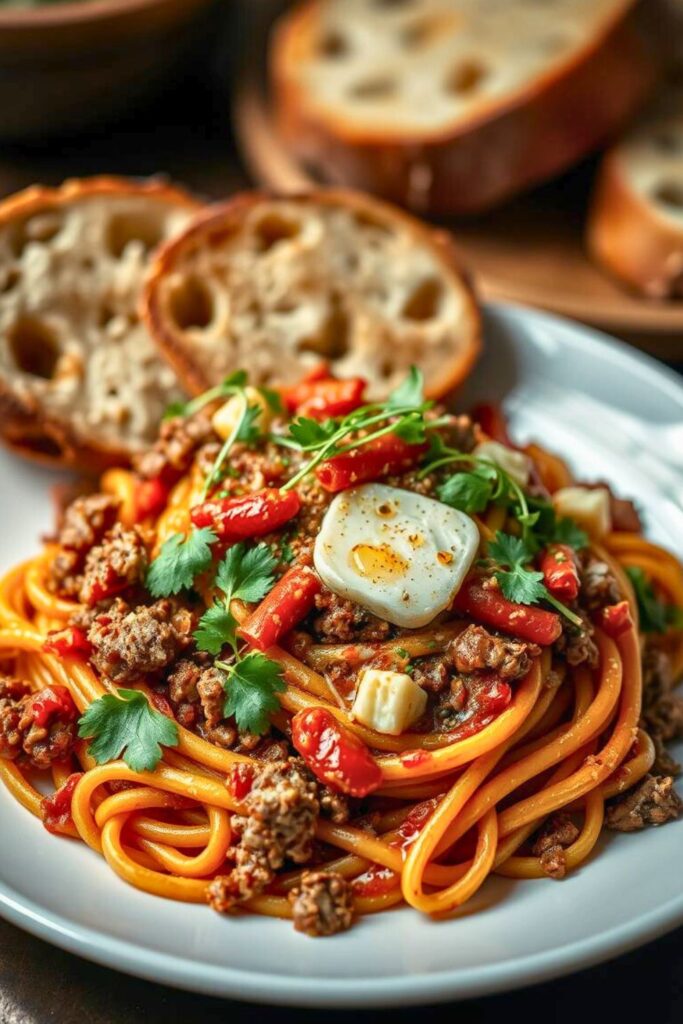Picture this: you’re wandering through Istanbul’s Grand Bazaar, the air thick with cumin and paprika, when you stumble into a tiny family restaurant. The owner’s grandmother shuffles over with a steaming bowl of something that looks like pasta but tastes like pure magic. That’s Turkish pasta for you, it’s gonna change everything you thought you knew about comfort food.
Turkish pasta isn’t your typical Mediterranean dish. It’s this beautiful collision of Ottoman culinary traditions and modern Turkish home cooking that creates something entirely unique. We’re talking about tender pasta tossed with aromatic spices, rich tomato based sauces, and often crowned with creamy yogurt or tangy cheese. This Turkish pasta represents comfort food that tells a story, one that spans centuries and connects families around dinner tables across Turkey.
What makes Turkish pasta so special? It’s how Turkish cooks treat pasta like family. They don’t just boil noodles and call it a day. They transform simple ingredients into something that’ll have you scraping the bowl clean and immediately planning your next batch. The secret lies in the layering of flavors, that perfect balance of warmth from the spices, richness from the sauce, and freshness from herbs makes every bite feel like a warm hug.
This isn’t just another pasta recipe to add to your collection. It’s your gateway into understanding how Turkish home cooks approach food, with respect for tradition but zero fear of making something delicious. Once you master this technique, you’ll find yourself reaching for these flavor combinations in everything you cook.
Why Turkish Pasta Deserves Kitchen Counter Space
Turkish cuisine transforms familiar ingredients into something completely new. Take pasta, something we all think we know, and watch it change under Turkish cooking techniques. The result is comfort food that’s both familiar and exotic, hearty yet refined.
Turkish pasta’s beauty lies in its flexibility. Some regions load it with lamb or beef, creating hearty meals for crowds. Others keep it lighter with vegetables and fresh herbs. Coastal areas might add seafood, while inland regions stick to rich, meat based sauces perfected over generations.
What really sets Turkish pasta apart is the spice blend. We’re not talking about overwhelming heat, but rather this complex layering of flavors that builds with each bite. Cumin, paprika, mint, and sometimes a touch of cinnamon create depth that’ll keep you coming back for more.
The Turkish Pasta Foundation: Understanding Flavor Profiles
Before we dive into cooking, let’s explore what makes Turkish flavors distinctive. Turkish cooks balance sweet, savory, and aromatic elements instinctively. They’ll add sugar to balance acidity, use fresh herbs to brighten rich sauces, and let spices truly shine.
Yogurt plays a crucial role in Turkish pasta. In Turkish cuisine, yogurt isn’t just garnish, it’s a flavor enhancer that adds richness and tang while cooling spice heat. When you dollop it on Turkish pasta, you’re completing a flavor profile developed over centuries.
Essential Ingredients & Smart Kitchen Swaps

Let’s start with what you’ll actually need, listed in the order you’ll use them, because that’s how real cooks think about ingredients.
For the pasta base, you’ll want a medium sized shape that holds sauce well. Turkish cooks often use whatever’s available, but penne, rigatoni, or even shells work beautifully. If you’re gluten free, those chickpea or lentil pastas actually work better here than in Italian dishes because Turkish flavors are bold enough to stand up to their nuttier taste.
The sauce starts with good olive oil, and I mean good. This isn’t the time for that stuff you bought at the gas station. You need something that’ll carry the flavors without fighting them. If you can’t find Turkish olive oil, a fruity Greek variety works perfectly.
For the aromatics, we’re talking onions, garlic, and fresh tomatoes. The onions should be yellow or white, sweet onions can make the sauce too cloying. Garlic needs to be fresh; those pre chopped jars just won’t cut it here. As for tomatoes, fresh is ideal, but good canned San Marzanos will work if fresh ones taste like cardboard.
The Spice Blend That Changes Everything
Here’s where Turkish pasta gets its personality. You’ll need sweet paprika, ground cumin, dried mint, and a tiny pinch of cinnamon. The paprika should be the star, Turkish paprika if you can find it, but Spanish sweet paprika works too. Hungarian paprika might be too smoky for this dish.
Can’t find dried mint? Fresh mint works, but add it at the end. No cumin? Ground coriander can pinch hit, though the flavor will be different. The cinnamon is optional but magical, it adds this subtle warmth that makes people wonder what your secret ingredient is.
Don’t forget the yogurt. Full fat Greek yogurt is your best bet, but Turkish yogurt (if you can find it) is even better. Dairy free? Coconut yogurt actually works surprisingly well, though it’ll add a subtle sweetness that changes the dish’s character.
Building Your Protein Options
Traditional Turkish pasta often features ground lamb or beef, but let’s be real, not everyone’s gonna find good lamb at their grocery store. Ground beef with a bit of extra fat works beautifully. Turkey or chicken work too, though they need more seasoning to compensate for their mildness.
Vegetarian? Crumbled feta, chickpeas, or even roasted eggplant can provide that rich, satisfying element the dish needs. The key is adding something with substance, Turkish cuisine isn’t about delicate flavors; it’s about bold, satisfying combinations.
Step by Step Magic: Building Layers of Flavor
Start with your pasta water, and I mean really start there. Salt it like the sea, because under seasoned pasta can’t be fixed later. Turkish cooks aren’t shy about salt, and neither should you be. Get that water boiling while you prep everything else.
Heat your olive oil in a large, heavy bottomed pan. We’re not talking about a delicate sauté here you want enough oil to really coat the bottom of the pan. Add your diced onions and cook them until they’re golden and sweet, not just translucent. This is where patience pays off. Rush this step and you’ll miss out on that caramelized sweetness that makes the whole dish sing.
Here’s something most recipes won’t tell you: add your garlic after the onions have had their moment. Garlic burns faster than onions, and burnt garlic tastes bitter. Once the onions are golden, add your minced garlic and cook just until fragrant, maybe thirty seconds.
The Sauce That Brings It All Together
Now comes the fun part. Add your ground meat (if using) and brown it properly. Don’t crowd the pan, and don’t stir too much. Let it develop those deep, caramelized edges that add complexity to every bite. Season it with salt and pepper as it cooks.
Once your meat is browned, add your spice blend. This is crucial, toasting the spices in the fat for about thirty seconds wakes them up and makes them more aromatic. The cumin should smell nutty, the paprika should deepen in color, and the whole kitchen should smell incredible.
Add your tomatoes next. If you’re using fresh, dice them and let them break down naturally. Canned tomatoes can go in crushed by hand, you want some texture, not a smooth sauce. Season with salt, pepper, and maybe a tiny pinch of sugar if your tomatoes are particularly acidic.
Let this sauce simmer while your pasta cooks. It should reduce slightly and develop a rich, complex flavor that’s gonna make your whole house smell like a Turkish kitchen. Taste and adjust as you go cooking is about constant adjustment, not blind faith in measurements.
Bringing It All Together
When your pasta is just shy of al dente, reserve a cup of that starchy pasta water before draining. This is liquid gold for bringing everything together. Drain the pasta and add it directly to your sauce pan.
Here’s where Turkish technique really shines. Toss the pasta with the sauce over medium heat, adding splashes of pasta water as needed to create a silky coating. The pasta should finish cooking in the sauce, absorbing all those beautiful flavors.
Taste and adjust your seasoning one final time. This is when you add that dried mint if you’re using it, or fold in fresh herbs if that’s your preference. The mint should be subtle but noticeable, it brightens the whole dish without overpowering it.
The Science Behind the Sizzle

Understanding why Turkish pasta works so well comes down to understanding how fat carries flavor. When you toast those spices in olive oil, you’re not just heating them, you’re extracting their fat soluble compounds and suspending them in a medium that’ll coat every strand of pasta.
The long, slow cooking of the onions creates natural sugars through the Maillard reaction. Those caramelized flavors provide a sweet base that balances the earthiness of the cumin and the mild heat of the paprika. It’s this balance that makes Turkish cuisine so satisfying, every element serves a purpose.
The pasta water trick isn’t just about consistency. That starchy water contains proteins and starches that help bind the sauce to the pasta. When you finish cooking the pasta in the sauce, you’re not just heating it, you’re creating a emulsion that ensures every bite is perfectly coated.
Why Yogurt Makes Everything Better
The yogurt element in Turkish pasta isn’t just a garnish, it’s a crucial component that completes the dish’s flavor profile. The acidity in yogurt brightens rich, heavy sauces while its creaminess provides textural contrast. It’s the same principle behind putting sour cream on a loaded baked potato, but elevated through centuries of Turkish culinary wisdom.
From a scientific standpoint, the proteins in yogurt help bind flavors together while its natural tanginess enhances the umami elements in the meat and tomatoes. It’s food science disguised as comfort food.
Making It Beautiful & Delicious
Presentation matters, even for comfort food. Serve your Turkish pasta in warmed bowls, this isn’t the time for cold plates. Create a small well in the center of each portion and add a generous dollop of yogurt. Sprinkle with fresh herbs like parsley or dill, and maybe a light dusting of paprika for color.
If you’re feeling fancy, a drizzle of good olive oil over the yogurt adds richness and makes everything look restaurant worthy. A few toasted pine nuts or a sprinkle of crumbled feta can elevate the dish without overwhelming its essential character.
Perfect Pairings
Turkish pasta pairs beautifully with simple sides that won’t compete with its bold flavors. A crisp salad with cucumber, tomatoes, and a lemon vinaigrette cuts through the richness perfectly. Warm pita bread or crusty sourdough provides textural contrast and helps soak up any lingering sauce.
For drinks, think about what would work in a Turkish home. Strong black tea after the meal, or a light red wine during. If you’re serving it for a dinner party, a medium bodied red like a Côtes du Rhône or even a Turkish wine if you can find one.
Troubleshooting & Variations
The most common mistake people make with Turkish pasta is under seasoning. Turkish cuisine is bold and flavorful, don’t be afraid to taste and adjust. If your sauce seems flat, it probably needs more salt or a touch more of your spice blend.
Another common issue is overcooking the pasta. Remember, it’s gonna finish cooking in the sauce, so pull it from the water when it still has a bit of bite. Al dente isn’t just an Italian concept, it works perfectly in Turkish preparations too.
Creative Variations to Try
Once you’ve mastered the basic technique, Turkish pasta becomes a canvas for creativity. Try adding roasted red peppers for sweetness, or throw in some spinach for color and nutrition. Coastal Turkish regions often add seafood, shrimp or mussels work beautifully with these flavors.
For a vegetarian version, try using crumbled feta and chickpeas instead of meat. The feta provides richness while the chickpeas add protein and texture. You could even experiment with different pasta shapes, Turkish cooks aren’t purists about this stuff.
Why This Turkish Pasta Recipe Will Become Your New Favorite

Turkish pasta represents something special in the world of comfort food. It’s familiar enough to feel like home but exotic enough to make dinner feel like an adventure. The combination of techniques, the long cooked aromatics, the careful spice toasting, the creamy yogurt finish, creates layers of flavor that develop with each bite.
This isn’t just another pasta recipe to add to your rotation. It’s a window into how Turkish home cooks approach food, with respect for tradition but zero fear of bold flavors. Once you understand these techniques, you’ll find yourself applying them to other dishes, creating that distinctive Turkish flavor profile that makes everything more interesting.
The beauty of Turkish pasta lies in its adaptability. Make it meaty for hearty appetites, keep it light for summer dinners, or go completely vegetarian without losing any of its essential character. It’s the kind of recipe that grows with you, becoming better as you make it more often and start to understand its rhythm.
Final Tips for Success
Don’t skip the pasta water, it’s crucial for creating that silky sauce that coats every strand. Taste constantly and adjust seasoning as you go. Turkish cuisine rewards boldness, so don’t be afraid to add more spices if the dish needs it.
Most importantly, don’t overthink it. Turkish home cooks have been making variations of this dish for generations, often without measuring anything. Trust your instincts, taste as you go, and remember that the best Turkish pasta is the one that makes you and your family happy.
Frequently Asked Questions
Can I make Turkish pasta ahead of time?
Turkish pasta is definitely best fresh, but you can make components ahead. The sauce actually improves after sitting for a day, so make that in advance and reheat it while cooking fresh pasta. Don’t combine them until you’re ready to serve, though, pasta gets mushy when reheated.
What if I can’t find Turkish or Greek yogurt?
Regular whole milk yogurt works fine, though it won’t be quite as thick. You can strain it through cheesecloth for an hour to remove some whey, making it more like Greek yogurt. Avoid non fat versions, they’ll curdle when they hit the hot pasta and won’t provide the richness the dish needs.
Is there a way to make this dish less rich?
Turkish cuisine isn’t known for being light, but you can make adjustments. Use less olive oil, choose leaner meat, or go with a lighter yogurt. You could also bulk up the dish with more vegetables like zucchini or bell peppers. Just remember that some richness is essential to the dish’s character.
Can I freeze Turkish pasta?
The sauce freezes beautifully for up to three months, but don’t freeze it with the pasta already mixed in. Cook fresh pasta and combine with thawed, reheated sauce for best results. The texture will be much better than trying to freeze the completed dish.
What’s the difference between this and regular pasta with meat sauce?
Turkish pasta has a completely different spice profile and cooking technique. The long cooked aromatics, the specific spice blend, and especially the yogurt finish create flavors you won’t find in Italian style meat sauces. It’s more aromatic, often includes unexpected elements like mint or cinnamon, and has that distinctive Turkish balance of rich and bright flavors.

Swiftly Captions by Tina Smith — Quick, flavorful food recipes made simple, bringing fresh inspiration to your kitchen every day






